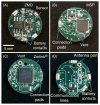Development of a wireless intra-vaginal transducer for monitoring intra-abdominal pressure in women
- PMID: 22147020
- PMCID: PMC3303945
- DOI: 10.1007/s10544-011-9611-x
Development of a wireless intra-vaginal transducer for monitoring intra-abdominal pressure in women
Abstract
Pelvic floor disorders (PFD) affect one of every four women in the United States. Elevated intra-abdominal pressure (IAP) during daily activity or strenuous physical activity has been identified as a risk factor in the prevalence of PFD. However, the relationship between IAP and physical activity is poorly understood and oftentimes activity restrictions are prescribed by physicians without clinical evidence linking various activities to elevated IAP. There are currently no pressure transducers capable of monitoring IAP non-invasively out of a clinical environment. To overcome this shortcoming, a novel intra-vaginal pressure transducer (IVT) was developed to continuously monitor IAP. Improvements were made to the first generation IVT by incorporating wireless capability to enhance the device's mobility while creating a more robust IAP monitoring system. To ensure the changes maintained the functionality of the original device design, comparison testing with standard clinical pressure transducers in both bench top and clinical settings was conducted. The wireless device was found to have high linearity, robust signal transmission, and dynamic response that outperforms the clinical standard rectal transducer and is similar to the original first generation non-wireless design. The wireless IVT presented here is a mobile wireless device capable of measuring, storing and transmitting IAP data during various physical activities.
Figures









Similar articles
-
Development of a novel intra-abdominal pressure transducer for large scale clinical studies.Biomed Microdevices. 2017 Aug 26;19(4):80. doi: 10.1007/s10544-017-0211-2. Biomed Microdevices. 2017. PMID: 28844111 Free PMC article. Clinical Trial.
-
Development of a novel intra-vaginal transducer with improved dynamic response.Biomed Microdevices. 2009 Dec;11(6):1213-21. doi: 10.1007/s10544-009-9339-z. Biomed Microdevices. 2009. PMID: 19629699 Free PMC article.
-
Reproducibility of intra-abdominal pressure measured during physical activities via a wireless vaginal transducer.Female Pelvic Med Reconstr Surg. 2015 May-Jun;21(3):164-9. doi: 10.1097/SPV.0000000000000167. Female Pelvic Med Reconstr Surg. 2015. PMID: 25730430 Free PMC article.
-
Recent advances in noninvasive flexible and wearable wireless biosensors.Biosens Bioelectron. 2019 Sep 15;141:111422. doi: 10.1016/j.bios.2019.111422. Epub 2019 Jun 18. Biosens Bioelectron. 2019. PMID: 31229794 Review.
-
[Prospcts of application of implantable microkelectromechanical systems for monitoring and analysis of parameters of blood circulation system].Med Tekh. 2015 Mar-Apr;(2):1-4. Med Tekh. 2015. PMID: 26477085 Review. Russian. No abstract available.
Cited by
-
Development of a novel intra-abdominal pressure transducer for large scale clinical studies.Biomed Microdevices. 2017 Aug 26;19(4):80. doi: 10.1007/s10544-017-0211-2. Biomed Microdevices. 2017. PMID: 28844111 Free PMC article. Clinical Trial.
-
Variables Affecting Intra-abdominal Pressure During Lifting in the Early Postpartum Period.Female Pelvic Med Reconstr Surg. 2018 Jul/Aug;24(4):287-291. doi: 10.1097/SPV.0000000000000462. Female Pelvic Med Reconstr Surg. 2018. PMID: 28727649 Free PMC article.
-
Activity restrictions after gynecologic surgery: is there evidence?Int Urogynecol J. 2013 May;24(5):719-24. doi: 10.1007/s00192-012-2026-2. Epub 2013 Jan 23. Int Urogynecol J. 2013. PMID: 23340879 Free PMC article. Review.
-
Intra-abdominal pressure during Pilates: unlikely to cause pelvic floor harm.Int Urogynecol J. 2015 Aug;26(8):1123-30. doi: 10.1007/s00192-015-2638-4. Epub 2015 Feb 12. Int Urogynecol J. 2015. PMID: 25672647 Free PMC article.
-
Biomarkers and biometric measures of adherence to use of ARV-based vaginal rings.J Int AIDS Soc. 2016 May 2;19(1):20746. doi: 10.7448/IAS.19.1.20746. eCollection 2016. J Int AIDS Soc. 2016. PMID: 27142091 Free PMC article. Review.
References
-
- AAMI. Association for the Advancement of Medical Instrumentation AAMI TIR No.9. 1992.
-
- AAMI. Association for the Advancement of Medical Instrumentation BP22. 1994.
-
- ANSI/AAMI (BP22:1994/(R) Blood Pressure Transducers. 2006.
-
- Coleman TJ, Hsu Y, et al. IEEE. 2010. - PubMed
-
- DeHennis AD, Wise KD. J Microelectromech Syst. 2005;14(1):12–22.
Publication types
MeSH terms
Grants and funding
LinkOut - more resources
Full Text Sources
Other Literature Sources
Medical
Research Materials

